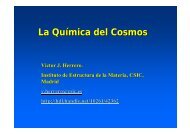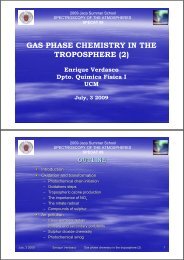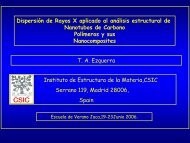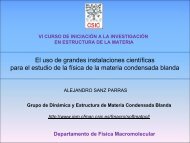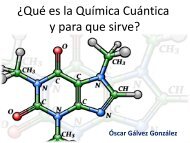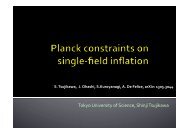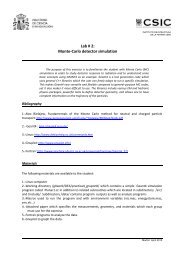ANNUAL REPORT 2011 - Instituto de Estructura de la Materia
ANNUAL REPORT 2011 - Instituto de Estructura de la Materia
ANNUAL REPORT 2011 - Instituto de Estructura de la Materia
Create successful ePaper yourself
Turn your PDF publications into a flip-book with our unique Google optimized e-Paper software.
educed. X-ray scattering results suggested that the exfoliated nanoc<strong>la</strong>y acted as stress concentrators, encounteringmore difficulties in orienting un<strong>de</strong>r the action of tensile stress, thus promoting loss of adhesion between thenanoc<strong>la</strong>y and polymer matrix and leading to rapid failure.RECRYSTALIZATION PROCESSES INPET: INTERPLAY BETWEEN STRUCTURE EVOLUTIONAND CONFORMATIONAL RELAXATIONThe changes induced in the amorphous regions of poly (ethylene terephtha<strong>la</strong>te) as a consequence of recrystallizationprocesses, taking p<strong>la</strong>ce after cold-crystallization at 100 ºC, were analyzed by means of isothermal dynamicalmechanical spectroscopy and microin<strong>de</strong>ntation hardness. Overall, a recrystallization process at either 115 ºC or 125ºC was found to induce an increase of the rigidity within the amorphous domains confined by the crystals.Microhardness measurements carried out at room temperature revealed that recrystallization lead to an enhancedmechanical performance of the amorphous regions. The analysis of isothermal segmental re<strong>la</strong>xation patternsrecor<strong>de</strong>d in a frequency interval of 10 -3 - 60 Hz indicated the appearance of two distinct contributions, which foundcorrespon<strong>de</strong>nce with observations by broad band dielectric spectroscopy on the same systems. The faster one wasascribed to segmental re<strong>la</strong>xation within the amorphous domains where the confinement by crystals is re<strong>la</strong>tivelyweak. The slow re<strong>la</strong>xation mo<strong>de</strong> was associated with regions where the conformational dynamics is stronglyrestricted by the crystals. A re<strong>la</strong>tive increase of the slow process was <strong>de</strong>tected upon recrystallization. A recently<strong>de</strong>veloped re<strong>la</strong>xation function mo<strong>de</strong>l was employed to estimate the size of the static cooperatively rearrangingregions for both, the slow and the fast mo<strong>de</strong>s. It was found that this size increased either upon <strong>de</strong>creasing thetemperature or as an effect of recrystallization. In addition, the number of monomers involved in a conformationalrearrangement turned out to be significantly <strong>la</strong>rger in the regions associated to the slow mo<strong>de</strong> process.HARDNESSAn update of “Hardness”, a review chapter in the Encyclopedia of Polymer Science and Technology published in2003, has been carried out. The article inclu<strong>de</strong>s the the basic principles of the hardness technique and a <strong>de</strong>scriptionof the various methods employed in the hardness <strong>de</strong>termination with special emphasis on the new generation of<strong>de</strong>pth-sensing instrumentation. The article also inclu<strong>de</strong>s the <strong>la</strong>test advances in the application of in<strong>de</strong>ntationtechniques to Polymer Science and provi<strong>de</strong>s a general overview of the corre<strong>la</strong>tions between the mechanisms of local<strong>de</strong>formation and the polymer basic nanostructural entities.From the experimental point of view, the production by means of spin-coating of a series of amorphous polymericthin films with varying thickness down to a few nanometers has been carried out. A method to precisely <strong>de</strong>terminethe film thicknes from nanohardness measurements is un<strong>de</strong>r <strong>de</strong>velopment in or<strong>de</strong>r to corre<strong>la</strong>te such values to theviscoe<strong>la</strong>stic properties of the materials.Group of DYNAMICS AND STRUCTURE OF SOFT AND POLYMER MATTERSTRUCTURE AND DYNAMICS OF SOFT AND POLYMERIC MATTER NANOSTRUCTRED INTHREE DIMENSIONSSemicrystalline Polymers. Following our research topic aiming to elucidate the interre<strong>la</strong>tion between the intrinsicbulk nanostructure of semicrystalline polymers and the segmental dynamics of the amorphous phase we have shownfor the first time that the combination of dielectric with neutron spin echo measurements performed in a mo<strong>de</strong>l<strong>de</strong>uterated polymer as poly(ethylene terephtha<strong>la</strong>te) reveals that the dynamics of semicrystalline polymers occurs inan homogeneous scenario simi<strong>la</strong>r to that valid to <strong>de</strong>scribe the dynamics of amorphous polymers. Accordingly, theintermolecu<strong>la</strong>r cooperativity is expected to be rather simi<strong>la</strong>r in both amorphous and semicrystalline polymers. Thereduced segmental mobility of the semicrystalline polymer is restricted to well differentiate regions, probably in thecrystal-amorphous interface.The significant broa<strong>de</strong>ning of the dielectric segmental re<strong>la</strong>xation in semicrystallinepolymers can be attributed to the averaging effect of measuring a homogeneous re<strong>la</strong>xation with simi<strong>la</strong>r stretchingexponents over an inhomogeneous environment.Within a simi<strong>la</strong>r context, the effects of strain-induced crystallization on the segmental dynamics of vulcanizednatural rubber (NR) have been studied by combining dielectric re<strong>la</strong>xation spectroscopy and wi<strong>de</strong>-angle X-rayscattering. We have shown that segmental dynamics is clearly affected by uniaxial stretching. At low strain levelsstretching takes p<strong>la</strong>ce without crystallization and a dramatic increase of the dielectric strength is observed. Thiseffect is accompanied by an increment of the dynamical fragility since as free volume reduces by stretching morecooperativity is nee<strong>de</strong>d in or<strong>de</strong>r to accomplish segmental motions. At higher strains crystals <strong>de</strong>velop and theinclusion of segments into the crystalline phase counteracts the dielectric increment. Our results support a73




